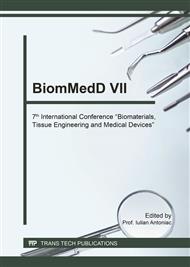[1]
A.P. Betrán, J. Ye, A.B. Moller, J. Zhang, A.M. Gülmezoglu, M.R. Torloni, The Increasing Trend in Caesarean Section Rates: Global, Regional and National Estimates: 1990-2014, PLoS One. 11(2) (2016) e0148343.
DOI: 10.1371/journal.pone.0148343
Google Scholar
[2]
H. Morris, Surgical pathology of the lower uterine segment caesarean section scar: is the scar a source of clinical symptoms?, Int J Gynecol Pathol 14(1) (1995) 16-20.
DOI: 10.1097/00004347-199501000-00004
Google Scholar
[3]
C. Nezhat, R. Falik, A. Li, Surgical management of niche, isthmocele, uteroperitoneal fistula, or cesarean scar defect: a critical rebirth in the medical literature, Fertility and Sterility 107(1) (2017) 69–71.
DOI: 10.1016/j.fertnstert.2016.10.017
Google Scholar
[4]
T.E. Bucknall, Factors influencing wound complications: a clinical and experimental study. Ann R Coll Surg Engl. 65 (1983) 71–77.
Google Scholar
[5]
C. Fabres, G. Aviles, C. De La Jara, J. Escalona, JF Muñoz, A. Mackenna, C. Fernández, F. Zegers-Hochschild, E. Fernández, The cesarean delivery scar pouch: clinical implications and diagnostic correlation between transvaginal sonography and hysteroscopy, J Ultrasound Med. 22(7) (2003).
DOI: 10.7863/jum.2003.22.7.695
Google Scholar
[6]
The CORONIS Collaborative Group, Caesarean section surgical techniques (CORONIS): a fractional, factorial, unmasked, randomized controlled trial, The Lancet 382(9888) (2013) 234–248.
DOI: 10.1016/s0140-6736(13)60441-9
Google Scholar
[7]
CORONIS collaborative group, Caesarean section surgical techniques: 3 year follow-up of the CORONIS fractional, factorial, unmasked, randomised controlled trial, Lancet 388(10039) (2016) 62-72.
DOI: 10.1016/s0140-6736(16)00204-x
Google Scholar
[8]
G. Gubbini, G. Centini, D. Nascetti, E. Marra, I. Moncini, L. Bruni, F. Petraglia, P. Florio, Surgical hysteroscopic treatment of cesarean-induced isthmocele in restoring fertility: prospective study., J Minim Invasive Gynecol. 18(2) (2011).
DOI: 10.1016/j.jmig.2010.10.011
Google Scholar
[9]
I.K. Stone, J.A. von Fraunhofer, B.J. Masterson, The biomechanical effects of tight suture closure upon fascia., Surg Gynecol Obstet. 163(5) (1986) 448-452.
DOI: 10.1016/s0022-5347(17)44393-x
Google Scholar
[10]
E. Bujold, C. Bujold, E.F. Hamilton, F. Harel, R.J. Gauthier, The impact of a single-layer or double-layer closure on uterine rupture, Am J Obstet Gynecol. 186(6) (2002) 1326-1330.
DOI: 10.1067/mob.2002.122416
Google Scholar
[11]
D.H. Riddick, C.T. DeGrazia, R.M. Maenza, Comparison of polyglactic and polyglycolic acid sutures in reproductive tissue, Fertil Steril. 28(11) (1977) 1220-1225.
DOI: 10.1016/s0015-0282(16)42920-1
Google Scholar
[12]
P.H. Craig, J.A. Williams, K.W. Davis, A.D. Magoun, A.J. Levy, S. Bogdansky, J.P. Jones, A biologic comparison of polyglactin 910 and polyglycolic acid synthetic absorbable sutures, Surg Gynecol Obstet. 141(1) (1975) 1-10.
Google Scholar
[13]
A. Leader, A. Fisher, T.J. Malkinson, P.J. Taylor, Histologic reaction to a new microsurgical suture in rabbit reproductive tissue, Fertil Steril. 40(6) (1983) 815-817.
DOI: 10.1016/s0015-0282(16)47486-8
Google Scholar
[14]
The CAESAR study collaborative group, Caesarean section surgical techniques: a randomized factorial trial (CAESAR), BJOG 117(11) (2010).
DOI: 10.1111/j.1471-0528.2010.02686.x
Google Scholar
[15]
G.T. Rodeheaver, J.G. Thacker, R.F. Edlich, Mechanical performance of polyglycolic acid and polyglactin 910 synthetic absorbable sutures, Surg Gynecol Obstet. 153(6) (1981) 835-841.
Google Scholar
[16]
O. Ceci, C. Cantatore, M. Scioscia, C. Nardelli, M. Ravi, A. Vimercati, S. Bettocchi, Ultrasonographic and hysteroscopic outcomes of uterine scar healing after cesarean section: comparison of two types of single-layer suture, J Obstet Gynaecol Res. 38(11) (2012).
DOI: 10.1111/j.1447-0756.2012.01872.x
Google Scholar


